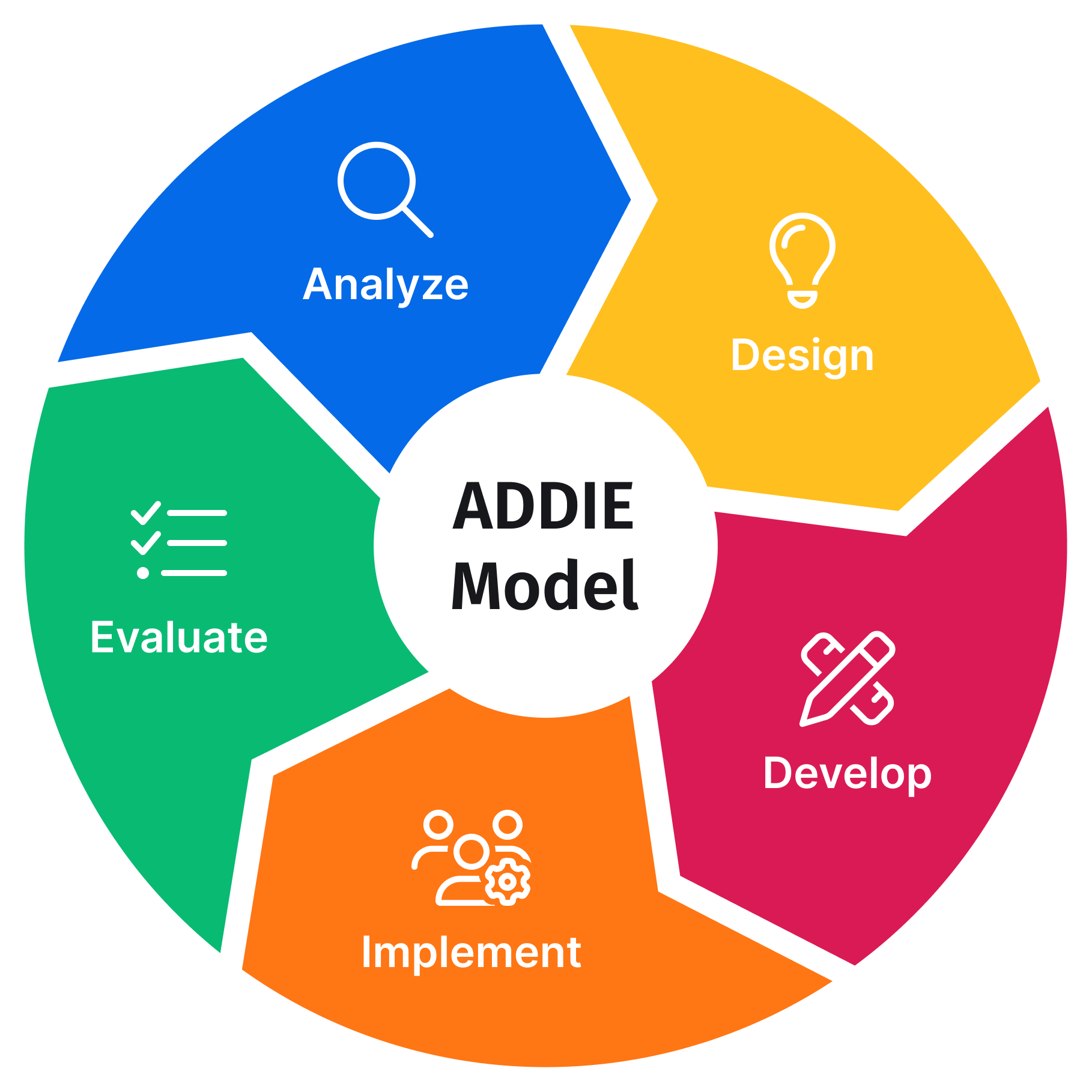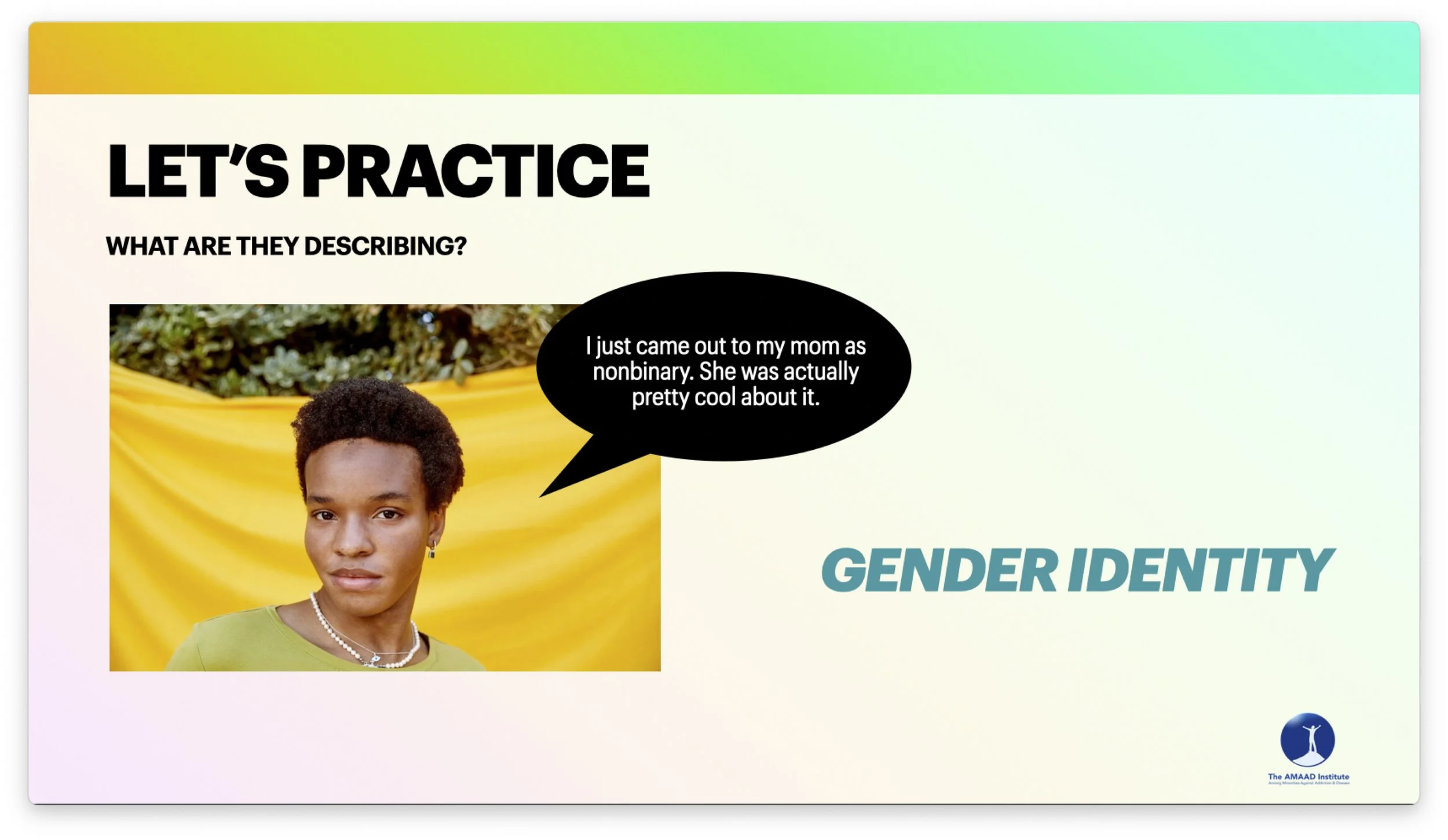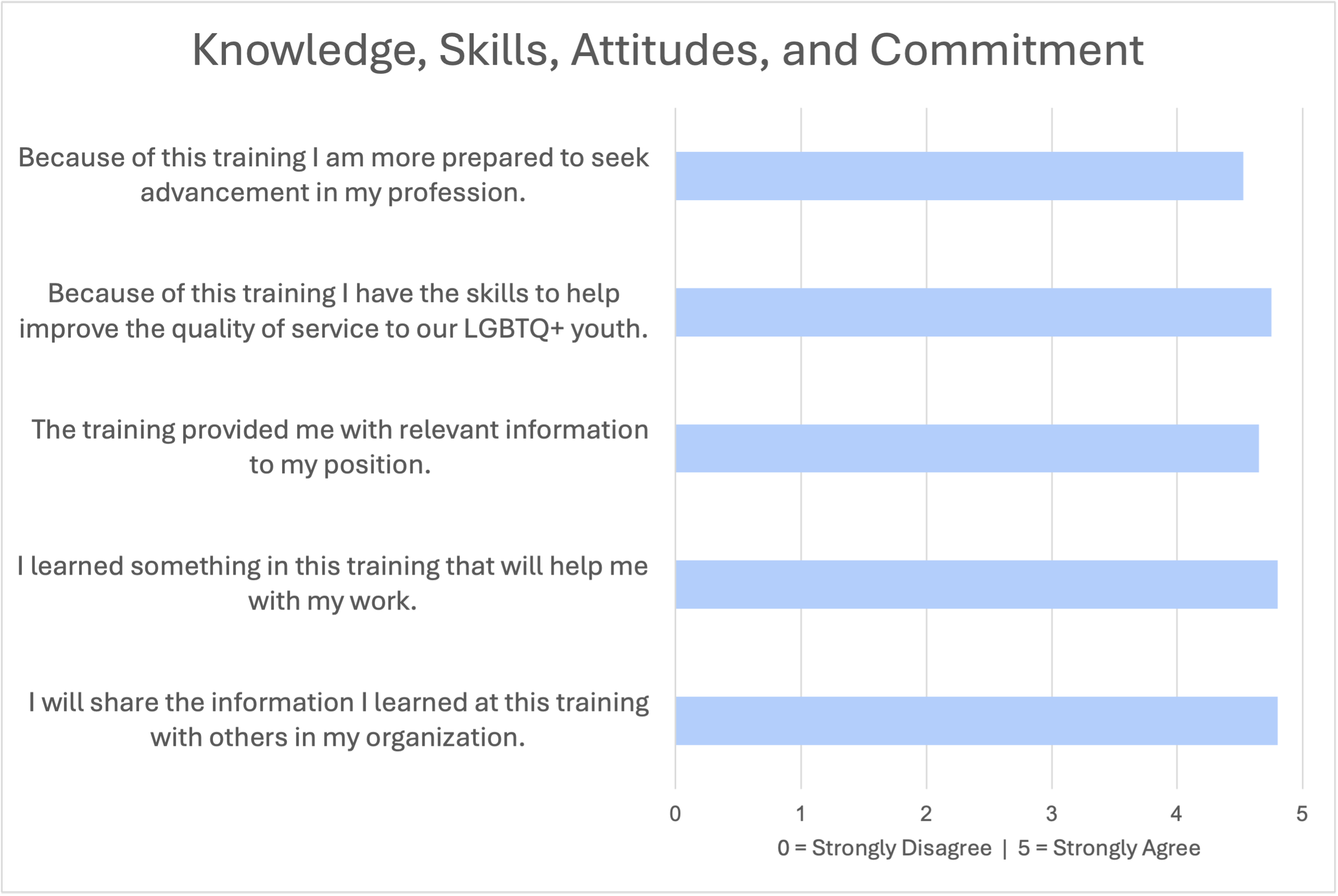
LGBTQ+ Equity for Youth Diversion Organization
The Project
A 6-hour intensive training for a youth diversion organization aiming to improve their services for LGBTQ+ youth and youth of color.
The Problem
LGB youth make up 20% of all youth in US juvenile justice facilities.¹¹¹¹
This equity issue concerns many organizations in Los Angeles, where youth who enter the justice system are 20-30% more likely to be charged with another crime.
The Client
This project’s client, a Los Angeles-based nonprofit, wanted to improve their diversion services for LGBTQ+ youth.
My Responsibilities
Analyze client needs.
Design workshop curriculum.
Develop 6 hours of learning content.
Facilitate the in-person training session.
Evaluate training results.
Tools
Analysis and Design
To create this course, I used the ADDIE model of instructional design.
The ADDIE model consists of five steps: Analyze, Design, Develop, Implement, and Evaluate.
Analyze
My analysis began with the organization itself.
I learned that the organization served youth ages 6+ who were at risk of entering the criminal justice system.
Next I analyzed the learners.
Using a pre-survey, I learned that staff were diverse in terms of race, age, and tenure.
Across programs, staff mostly worked directly with youth and families.
The group had varying levels of comfort and prior knowledge with the subject of LGBTQ+ terms and equity practices.
My final analysis was of the project considerations and constraints.
The client requested a three-month timeline. They preferred a one-day, in-person intensive training in order to build relationships among a primarily remote staff.
Possible learner profiles based on the analysis.
Design
Based on the analysis, I created five key goals for the training.
The goals reflected the critical behaviors that the staff would have to practice in their daily work following the training.
I broke the session into four segments of content. Each contained the content delivery, a practice activity, and a short discussion on why the information was relevant to the work.
I planned for instruction to begin with strong scaffolding for learners with less prior knowledge. I focused on helping them define terms and understand the value of using an equity lens.
As instruction proceeded, I used more generative instructional methods. This challenges learners to think for themselves. Based on what was learned, how would they approach a difficult situation?
The training ended with extended breakouts in which staff gathered in teams to brainstorm action steps. These action steps formed the basis for long-term follow-up.
Training Goals and Overview
Goal
Unit
Content
Create a safer space for youth to disclose their identity journey.
Part 3: On Their Terms: Relationships and Coming Out
Messages and Messengers
Coming out milestones
In Their Voices
Accepting vs. rejecting
Policy and practice
Breakouts and Discussion
Use guidelines for protecting youth privacy and confidentiality.
Part 2: Consent and Confidentiality
Youth privacy guidelines
Learning Lab – DeAndre
Why data collection helps
Breakouts and Discussion
Apply these insights to people, policy, and practice.
Part 4: On the Job
Action Planning
Evaluation
Closing
Use inclusive language.
Differentiate between sex, gender identity, gender expression, and sexual orientation.
Part 1: Language Matters
Learning Lab – Meeting Alex
The LGBTQIA+ Acronym
Practice with SOGIE
Policy and Practice
Breakouts and Discussion
Bootstrapping
Featured sources: National Library of Medicine, The Trevor Project, NASW, SME interviews
To create course content, I drafted early ideas through a bootstrapping process. I used a two-pronged approach of scholarly and web research, as well as consulting with Subject Matter Experts (SMEs).
-
I drew on resources from service providers who were innovating in the field of care for LGBTQ+ youth.
Key literature for social work best practices included reports from the National Association of Social Workers (NASW) and the Lambda Legal Defense & Education Fund (Lambda Legal).
Literature for bias and inclusive language included a toolkit from the University of Nebraska Medical Center, toolkit guidelines from the Coalition for Diversity and Inclusion in Scholarly Communications, a Trevor Project survey, and a report from San Francisco State University’s Family Acceptance Project.
-
I drew on scholarly research from the National Library of Medicine to draft content about coming out milestones, and Pew Research studies for qualitative and quantitative information about the coming out experience.
-
I conducted interviews with SMEs in the field of youth support and LGBTQ+ issues. My SMEs were LGBTQ+ professionals of color in the public sector.
They shared personal experiences with accepting vs. rejecting behaviors, ways they expected others to correct mistakes, and elements that have made spaces feel welcoming for them. These experiences I was able to work into later scenarios for group problem-solving.
Finally, I consulted with the organization staff themselves. I asked about common challenges they experienced, places where they felt uncertain, and specific instances they might like to unpack as a group.
Practice and Feedback
I ensured that each segment of content asked learners to apply their knowledge as a skill.
Feedback usually took the form of instructor comments, or group perspectives on the answer.
For example, in a scenario, staff would be invited to share their reasoning behind their selection. After the preferred answer was revealed, staff would be invited to reflect on how they knew the correct or incorrect answer. This also allowed staff with more prior knowledge to support their novice counterparts.
Overall, practice was designed with conversation, interactivity, and critical thinking in mind.
Activity: Scenario
Feedback: Instructor and group discussion
Goal: Use inclusive language
Activity: Name the identity (terminology recall)
Feedback: Answer revealed on slide, group discussion
Goal: Differentiate between sex, gender identity, gender expression, and sexual orientation
Activity: Group discussion
Feedback: Peer feedback, instructor affirmation
Goal: Apply these insights to people, policy, and practice
Learning Environment
The space was set up to promote learner engagement and recall.
Staff were seated in groups, with paper, colored pencils, candy, PlayDoh, and flashcards in the center of each table.
The “fun” materials helped learners relieve potential cognitive overload, while the writing materials supported memory aid.
I also hung terms and their definitions on large sheets around the room.
This quick visual reference supported recall and helped learners who possibly felt hesitant to ask questions.
Several activities, such as Agree/Disagree, required learners to circulate the room and engage with information on the walls. Because the PowerPoint had the risk of becoming static, I prioritized staff moving around the room.
Results
I evaluated results using the New World Kirkpatrick Model.
-
3- and 6-month feedback showed:
Staff are transitioning to a more inclusive intake documentation system.
A new intake assessment form reflects updated language and goals from the training.
Through longer term follow-up I will assess broader outcomes for the organization’s LGBTQ+ youth.
-
3- and 6-month feedback showed:
An office redesign squad is considering ways to make the space more welcoming as the staff shifts into onsite work.
-
Survey results (n=20) showed an increase in learner competencies in all five target areas.
Most encouragingly, staff reported that they now have the skills to improve service quality for LGBTQ+ youth.
-
Post-survey results showed:
Learners appreciated my (the instructor’s) energy, enthusiasm, and ability to share information in a way that was easily processed.
Scenarios helped make discussion “not stagnant.” Staff described the scenarios as “real-life,” “relevant,” and “personal.”
Staff appreciated hearing their peers’ perspectives. The “open discussions,” having space to “share, debate, and discuss,” and hearing coworkers’ experiences were a recurring theme for this group.
I used Microsoft Excel to clean and visualize survey data.
Qualitative Feedback
“I really enjoyed how it was hands on. This allowed me to be more involved and understanding of what was going on.”
“[I liked best] Scenarios that were relevant to case management experience.”
“[It could be improved by] More scenarios and small group breakouts. Thank you so much!!!”
“[I liked best] The opportunity to hear and learn about LGBTQIA real life scenarios.”
Key Takeaways
Designing and facilitating this training was an incredible learning experience.
I’m particularly proud that my scenarios were relevant and impactful for the group. I’m also glad that my enthusiasm for the topic came through!
If I could do it over, I’d incorporate more videos to help learners for whom reading creates higher cognitive load. This would also help amplify the voices and image of LGBTQ+ youth. I would also scaffold the action planning at the end of the training by offering an example of what such a plan could look like.
Thank you for reading. Ready to work together? Let’s go!
Sources
(1) Center for American Progress, Movement Advancement Project, & Youth First. (2017). UNJUST: LGBTQ YOUTH INCARCERATED IN THE JUVENILE JUSTICE SYSTEM. https://www.lgbtmap.org/file/lgbtq-incarcerated-youth.pdf
(2) Los Angeles County Department of Youth Diversion and Development. (2022). Designing youth diversion & development in Los Angeles County: A collaborative history told with youth leaders. In Lacounty.gov. https://file.lacounty.gov/SDSInter/dhs/1125236_YDDBOOKLET-052422.pdf
















